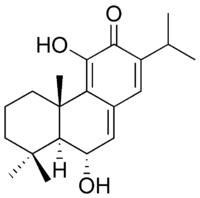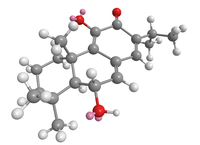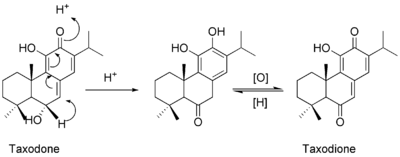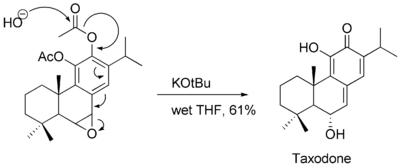Taxodone
 | |
 | |
| Names | |
|---|---|
| IUPAC name
(4bS,8aS,9S)-4,9-Dihydroxy-4b,8,8-trimethyl-2-propan-2-yl-6,7,8a,9-tetrahydro-5H-phenanthren-3-one | |
| Other names
6,11-Dihydroxyabieta-7,9(11),13-trien-12-one, NSC122420, AC1L9XIL, CID457961 | |
| Identifiers | |
| 19039-02-2 | |
| 3D model (Jmol) | Interactive image |
| ChemSpider | 242416 |
| PubChem | 275528 |
| |
| |
| Properties | |
| C20H28O3 | |
| Molar mass | 316.44 g·mol−1 |
| Appearance | Golden crystalline solid |
| Melting point | 176 to 177 °C (349 to 351 °F; 449 to 450 K) |
| Insoluble | |
| Solubility in chloroform, alcohol, hexane, ether | Soluble |
| Related compounds | |
| Related compounds |
Taxodione |
| Except where otherwise noted, data are given for materials in their standard state (at 25 °C [77 °F], 100 kPa). | |
| | |
| Infobox references | |
Taxodone is a naturally occurring diterpenoid found in Taxodium distichum (Bald Cypress), Rosmarinus officinalis (Rosemary), several Salvia species and other plants, along with its oxidized rearrangement product, taxodione. Taxodone and taxodione exhibit anticancer,[1][2][3] antibacterial,[4][5][6] antioxidant,[7] antifungal,[8] insecticide,[9] and antifeedant[10] activities.
Discovery
Taxodone was first isolated in 1968 from the seeds of Taxodium distichum (Bald Cypress) by S. Morris Kupchan and coworkers.[1] They reported the structure determination and basic chemistry of taxodone and its oxidized rearrangement product, taxodione.[11][12] Taxodone occurs naturally in the form of (+)-taxodone.
Occurrence
Taxodone and/or taxodione have been identified in several plants besides Taxodium distichum including: Rosmarinus officinalis (Rosemary),[13] Salvia barrelieri,[7] Metasequoia glyptostroboides (Dawn Redwood),[4] Salvia munzii (San Diego Sage),[14] Salvia moorcroftiana,[15] Salvia staminea,[16] Salvia clevelandii (Cleveland Sage),[17] Salvia hypargeia,[3] Salvia broussonetii,[18] Salvia montbretii,[19][20] Salvia nipponica,[21][22] Salvia verbenaca (Wild Clary),[23] Salvia lanigera,[24][25]Salvia prionitis,[26] Salvia deserta,[27] Salvia phlomoides,[28][29] and Plectranthus hereroensis[30]
Taxodone, taxodione and their reaction products have been used as archeological and geological biomarkers.[31][32][33][34][35][36][37]
Analogs of taxodone and taxodione have also been isolated. 2-hydroxy taxodone and 2-hydroxy-taxodione have been found in Salvia texana (Texas Sage).[38] 5,6-Didehydro-7-hydroxy-taxodone was found in Salvia munzii.[14] 7-Hydroxytaxodione, 7,7‘-bistaxodione, and 11,11‘-didehydroxy-7,7‘-dihydroxytaxodione were found in Salvia montbretti.[19][20]
Activity
Taxodone and taxodione possess in vivo activity against Walker intramuscular carcinosarcoma 256 in rats (25 and 40 mg/kg, respectively) and in vitro activity against cells derived from human carcinoma of the nasopharynx (KB) (ED50 = 0.6 and 3 ug/ml respectively).[1] Taxodone and taxodione exhibit antifungal activity against wood decay fungi, with taxodione being especially active against Trametes versicolor and Fomitopsis palustris.[8] Taxodione exhibited the highest antioxidant activity among the tested diterpenoids from the roots of Salvia barrelieri.[7] Taxodone showed potent antibacterial effects against foodborne pathogenic bacteria, such as Listeria monocytogenes ATCC 19166, Salmonella typhimurium KCTC 2515, Salmonella enteritidis KCTC 2021, Escherichia coli ATCC 8739, Escherichia coli O157:H7 ATCC 43888, Enterobacter aerogenes KCTC 2190, Staphylococcus aureus ATCC 6538 and Staphylococcus aureus.KCTC 1916[4] Taxodone showed potent termicidal activity against the subterranean termite, Reticulitermes speratus Kolbe.[9] Taxodione depresses neruonal GABAA receptor-operated Cl-current (IGABA).[39] Taxodione may have potential in treatment of cardiovascular disease.[40]
The use of taxodone and taxodione to inhibit hair growth has been patented.[41][42][43] Treatment of benign prostate enlargement with taxodone has also been patented.[44]
Chemistry
Taxodone was the first isolated example of a quinone methide[45][46][47][48][49][50] with a labile hydrogen adjacent to this reactive chromophore.[1] Kupchan demonstrated that taxodone aromatizes to a catechol ketone upon exposure to mild acid. Air oxidation of this catechol ketone affords taxodione.

Synthesis
Taxodone rearranges easily in the presence of mild acids and reacts readily with nucleophiles. Although taxodone shows higher anticancer and antibacterial activity than taxodione it eluded creation in the laboratory for over 25 years because of its inherent instability. During this time several different groups reported syntheses of the more stable taxodione.[51][52][53][54][55][56][57][58][59][60][61][62][63][64][65][66][67][68][69]
In 1993 taxodone was synthesized for the first time in a 16 step sequence utilizing a unique phenol benzylic epoxide electron reorganization in the final step.[70][71] As taxodone readily decomposes into taxodione this synthesis of taxodone also constitutes a formal synthesis of taxodione as well.

Since the synthesis of taxodone there have been additional syntheses of taxodione and analogs.[6][72][73]
Notes and references
- 1 2 3 4 Kupchan, S. M.; Karim, A; Marcks, C. (1968). "Tumor inhibitors. XXXIV. Taxodione and taxodone, two novel diterpenoid quinone methide tumor inhibitors from Taxodium distichum". J. Am. Chem. Soc. 90 (21): 5923–5924. doi:10.1021/ja01023a061.
- ↑ Zaghloul A. M.; Gohar A. A.; Naiem Z. A.; Abdel Bar F. M. (2008). "Taxodione, a DNA-binding compound from Taxodium distichum L. (Rich.).". Z. Naturforsch. C. 63 (5–6): 355–360.
- 1 2 Ayhan Ulubelen, Gülaçti Topçu, Hee-Byung Chai and John M. Pezzuto (1999). "Cytotoxic Activity of Diterpenoids Isolated from Salvia hypargeia". Pharmaceutical Biology. 37 (2): 148–151. doi:10.1076/phbi.37.2.148.6082.
- 1 2 3 Vivek K. Bajpai & Sun Chul Kan (2010). "Antibacterial abietane-type diterpenoid, taxodone from Metasequoia glyptostroboides Miki ex Hu". Journal of Bioscience. 35 (4): 533–538. doi:10.1007/s12038-010-0061-z.
- ↑ Vivek K. Bajpai; Minkyun Na; Sun Chul Kang (2010). "The role of bioactive substances in controlling foodborne pathogens derived from Metasequoia glyptostroboides Miki ex Hu". Food and Chemical Toxicology. 48 (7): 1945–1949. doi:10.1016/j.fct.2010.04.041.
- 1 2 Tada M.; Kurabe J.; Yoshida T.; Ohkanda T.; Matsumoto Y. (2010). "Syntheses and antibacterial activities of diterpene catechol derivatives with abietane, totarane and podocarpane skeletons against methicillin-resistant Staphylococcus aureus and Propionibacterium acnes". Chem Pharm Bull (Tokyo). 58 (6): 818–824. doi:10.1248/cpb.58.818.
- 1 2 3 Ufuk Kolak; Ahmed Kabouche; Mehmet Öztürk; Zahia Kabouche; Gülaçtl Topçu; Ayhan Ulubelen (2009). "Antioxidant diterpenoids from the roots of Salvia barrelieri". Phytochemical Analysis. 20 (4): 320–327. doi:10.1002/pca.1130.
- 1 2 Norihisa Kusumoto, Tatsuya Ashitani, Tetsuya Murayama, Koichi Ogiyama and Koetsu Takahashi (2010). "Antifungal Abietane-Type Diterpenes from the Cones of Taxodium distichum Rich". Journal of Chemical Ecology. 36 (12): 1381–1386. doi:10.1007/s10886-010-9875-2.
- 1 2 Norihisa Kusumoto, Tatsuya Ashitani, Yuichi Hayasaka, Tetsuya Murayama, Koichi Ogiyama and Koetsu Takahashi (2009). "Antitermitic Activities of Abietane-type Diterpenes from Taxodium distichum Cones". Journal of Chemical Ecology. 35 (6): 635–642. doi:10.1007/s10886-009-9646-0.
- ↑ M. C. Ballesta-Acosta1, M. J. Pascual-Villalobos and B. Rodríguez (2008). "Short communication. The antifeedant activity of natural plant products towards the larvae of Spodoptera littoralis". Spanish Journal of Agricultural Research. 6 (1): 85–91. doi:10.5424/sjar/2008061-304.
- ↑ Kupchan, S. M.; Karim, A; Marcks, C. (1969). "Tumor inhibitors. XLVIII. Taxodione and taxodone, two novel diterpenoid quinone methide tumor inhibitors from Taxodium distichum". J. Org. Chem. 34 (12): 3912–3918. doi:10.1021/jo01264a036.
- ↑ Hanson, R. C.; Lardy, H. A.; Kupchan, S. M. (1970). "Inhibition of phosphofructokinase by quinone methide and alpha-methylene lactone tumor inhibitors". Science. 168 (3929): 378–380. doi:10.1126/science.168.3929.378.
- ↑ El-Lakany, Abdalla M. (2004). "Chlorosmaridione; A Novel Chlorinated Diterpene Quinone Methide from Rosemarinus officinalis L". Natural Product Sciences. 10 (2): 59–62.
- 1 2 Luis, J. G.; Grillo, T. A. (1993). "New diterpenes from Salvia munzii: chemical and biogenetic aspects". Tetrahedron. 49 (28): 6277–6284. doi:10.1016/S0040-4020(01)87965-5.
- ↑ Simoes, F.; Michavila, A.; Rodriguez, B.; Garcia Alvarez, M. C.; Mashooda, H. (1986). "A quinone methide diterpenoid from the root of Salvia moorciuftiana". Phytochemistry. 25 (3): 755–756. doi:10.1016/0031-9422(86)88043-8.
- ↑ Gulacti Topcu1, Esra N. Altiner, Seyda Gozcu, Belkis Halfon, Zeynep Aydogmus, J. M. Pezzuto, Bing-Nan Zhou, David G. I. Kingston (2003). "Studies on Di- and Triterpenoids from Salvia staminea with Cytotoxic Activity". Planta Med. 69 (5): 464–467. doi:10.1055/s-2003-39705.
- ↑ Iván C. Guerrero; Lucía S. Andrés; Leticia G. León; Rubén P. Machín; José M. Padrón; Javier G. Luis & José Delgadillo (2006). "Abietane Diterpenoids from Salvia pachyphylla and S. clevelandii with Cytotoxic Activity against Human Cancer Cell Lines". J. Nat. Prod. 69 (12): 1803–1805. doi:10.1021/np060279i. PMID 17190465.
- ↑ M. Fraga; Carmen E. Díaz; Ana Guadaño & Azucena González-Coloma (2005). "Diterpenes from Salvia broussonetii Transformed Roots and Their Insecticidal Activity". J. Agric. Food Chem. 53 (13): 5200–5206. doi:10.1021/jf058045c.
- 1 2 Ayhan Ulubelen; Gülaçti Topcu (1996). "New Abietane Diterpenoids from Salvia montbretii". J. Nat. Prod. 55 (4): 441–444. doi:10.1021/np50082a006.
- 1 2 Ayhan Ulubelen; Gülaçti Topcu (1996). "Abietane and Rearranged Abietane Diterpenes from Salvia montbretii". J. Nat. Prod. 59 (8): 734–737. doi:10.1021/np9602224.
- ↑ Ikeshiro Y.; Mase I.; Tomita Y. (1991). "Abietane-Type Diterpene Quinones from Salvia nipponica". Planta Med. 57 (6): 588. doi:10.1055/s-2006-960219.
- ↑ Hsiu-Hui Chana, Tsong-Long Hwangb, Chung-Ren Sua, Mopur Vijaya Bhaskar Reddya and Tian-Shung Wu (2011). "Anti-inflammatory, anticholinesterase and antioxidative constituents from the roots and the leaves of Salvia nipponica Miq. var. formosana". Phytomedicine. 18 (2–3): 148–150. doi:10.1016/j.phymed.2010.06.017.
- ↑ A. Kabouche, Z. Kabouche, R. Touzani and C. Bruneau (2008). "Diterpenes and sterols from the roots of Salvia verbenaca subsp. clandestina". Chemistry of Natural Compounds. 44 (6): 824–825. doi:10.1007/s10600-009-9204-6.
- ↑ Ik-Soo Lee; Norito Kaneda; Rutt Suttisri; Abdalla M. El-Lakany; Nawal Sabri & A. Douglas Kinghorn (1998). "New Orthoquinones from the Roots of Salvia lanigera". Planta Med. 64 (7): 632–634. doi:10.1055/s-2006-957536.
- ↑ Sabri, N. N., Abou-Donia, A. A., Assad, A. M., Ghazy, N. M., El-lakany, A. M., Tempesta, M. S. and Sanson D. R. (1989). "Abietane diterpene quinones from the roots of Salvia verbenaca and S. lanigera". Planta Medica. 55 (6): 582. doi:10.1055/s-2006-962111.
- ↑ Li M.; Zhang J. S.; Ye Y. M.; Fang J. N. (2000). "Constituents of the roots of Salvia prionitis". J Nat Prod. 63 (1): 139–141. doi:10.1021/np990357k.
- ↑ Y. Tezuka; R. Kasimu; J. X. Li; P. Basnet; K. Tanaka; T. Namba; S. Kadot (1998). "Constituents of Roots of Salvia deserta SCHANG. (Xinjiang-Danshen)". Chem Pharm Bull. 46 (1): 107–112. doi:10.1248/cpb.46.107.
- ↑ Benjamın Rodrıguez (2003). "A Methoxyabietane Diterpenoid from the Root of Salvia phlomoides and Structural Correction of Another Diterpene from Cryptomeria japonica". Z. Naturforsch. 58b: 324–327.
- ↑ J. A. Hueso-Rodrıguez; M. L. Jimeno; B. Rodrıguez; G. Savona; M. Bruno (1983). "Abietane diterpenoids from the root of Salvia phlomoides". Phytochemistry. 22 (9): 2005–2009. doi:10.1016/0031-9422(83)80033-8.
- ↑ Olga Batista, M. Fátima Simões, José Nascimento, Sofia Riberio, Aida Duartea, Benjamín Rodríguez and Maria C. de la Torreb (1996). "A rearranged abietane diterpenoid from Plectranthus hereroensis". Phytochemistry. 41 (2): 571–573. doi:10.1016/0031-9422(95)00646-X.
- ↑ A. Otto; H. Walther; W. Püttmann (1997). "Sesqui- and diterpenoid biomarkers preserved in Taxodium-rich Oligocene oxbow lake clays, Weisselster basin, Germany". Organic Geochemistry. 26 (1–2): 105–115. doi:10.1016/S0146-6380(96)00133-7.
- ↑ A. Otto; H. Walther; W. Püttmann (1994). "Molecular composition of a leaf- and root-bearing Oligocene Oxbow Lake Clay in the Weisselster Basin, Germany". Organic Geochemistry. 22 (2): 275–286. doi:10.1016/0146-6380(94)90174-0.
- ↑ Angelika Otto; Bernd R. T. Simoneit; William C. Rember (2003). "Resin compounds from the seed cones of three fossil conifer species from the Miocene Clarkia flora, Emerald Creek, Idaho, USA, and from related extant species". Review of Palaeobotany and Palynology. 126 (3–4): 225–241. doi:10.1016/S0034-6667(03)00088-5.
- ↑ Maya Stefanova; Bernd R.T. Simoneit (2008). "Polar aromatic biomarkers of Miocene-aged Chukurovo resinite and correlation with a progenitor macrofossil". International Journal of Coal Geology. 75 (3): 166–174. doi:10.1016/j.coal.2008.05.003.
- ↑ A. Zdravkov; A. Bechtel; R. F. Sachsenhofer; J. Kortenski; R. Gratzer (2011). "Vegetation differences and diagenetic changes between two Bulgarian lignite deposits – Insights from coal petrology and biomarker composition". Organic Geochemistry. 42 (3): 237–254. doi:10.1016/j.orggeochem.2010.12.006.
- ↑ Yann Hautevelle; Raymond Michels; Fabrice Malartre; Alain Trouiller (2006). "Vascular plant biomarkers as proxies for palaeoflora and palaeoclimatic changes at the Dogger/Malm transition of the Paris Basin (France)". Organic Geochemistry. 37 (5): 610–625. doi:10.1016/j.orggeochem.2005.12.010.
- ↑ Kenneth E. Peters; Clifford C. Walters; J. Michael Moldowan (2005). "The Biomarker Guide: Biomarkers and isotopes in petroleum systems and Earth History". 2: 546.
- ↑ Gonzalez, A. G.; Aguilar, Z. E.; Luis, J. G; Ravelo, A. G.; Dominguez, X. (1988). "Quinone methide diterpenoids from the roots of Salvia texana". Phytochemistry. 27: 1777–1781. doi:10.1016/0031-9422(88)80442-4.
- ↑ D. Rutherford; M. Nielsen; N. Tokutomi; N. Akaike (1994). "Effects of plant diterpenes on the neuronal GABAA receptor-operated chloride current". Neuroreport. 5 (18): 2569–2572. doi:10.1097/00001756-199412000-00041.
- ↑ C. R. Tirapelli; S. R. Ambrosio; F. B. da Costa; A. M. de Oliveira (2008). "Diterpenes: a therapeutic promise for cardiovascular diseases". Recent Patents Cardiovasc Drug Discov. 3: 1–8. doi:10.2174/157489008783331689.
- ↑ US Patent 5824665
- ↑ US Patent 6218435
- ↑ US Patent 20070203240
- ↑ World Patent 2004064736
- ↑ Karantsios, D.; Scarpa, J. S.; Eugster, C. H. (1966). "Struktur von Fuerstion". Helv. Chim. Acta. 49 (3): 1151–1172. doi:10.1002/hlca.19660490313.
- ↑ Gonzalez, A. G.; Fraga, B. M.; Gonzalez, C. M. (1983). Tetrahedron. 84: 3033. Missing or empty
|title=(help) - ↑ Simoes, F.; Miehavila, A; Rodriguez. B.; Garcia A1varez, M. C.; Mashooda, H. (1986). "A quinone methide diterpenoid from the root of Salvia moorciuftiana". Phytochemistry. 25 (3): 755–756. doi:10.1016/0031-9422(86)88043-8.
- ↑ Sankaram, A. V. B.; Murthi, M. M.; Bhaskaraiah, K.; Narasimha Rao, G. L.; Suhrahmanyam, M.; Shoolery, J. N. (1988). "Bharangin, a novel diterpenoid quinonemethide from pygmacopremna herbacea (Roxb.) moldenke". Tetrahedron Lett. 29 (2): 245–248. doi:10.1016/S0040-4039(00)80066-0.
- ↑ Fernando, H. C.; Gunatilaka, A. A. L.; Kumar, V.; Weexatunga, G. (1988). "Two new quinone-methides from cassine balae: Revised structure of balaenonol". Tetrahedron Lett. 29 (3): 387–390. doi:10.1016/S0040-4039(00)80104-5.
- ↑ Sankaram, A. V. B.; Bhaskaraiah, K.; Marthandamurthi. M.; Subrahmanyam, M. (1989). "Isobharangin, a new biogenetically significant diterpenoid quinonemethide from pygmacopremna herbacea (Roxb.) moldenke". Tetrahedron Lett. 30 (7): 867–868. doi:10.1016/S0040-4039(01)80638-9.
- ↑ Mori, K.; Matsui, M. (1970). "Diterpenoid total synthesis. XIII Taxodione, a quinone methide tumor inhibitor". Tetrahedron. 26 (14): 3467–3473. doi:10.1016/S0040-4020(01)92926-6.
- ↑ Matsumoto, T.; Tachibana, Y.; Uchida, J.; Fukui, K. (1971). "The Total Synthesis of (±)-Taxodione, A Tumor Inhibitor". Bull. Chem. Soc. Jpn. 44 (10): 2766–2770. doi:10.1246/bcsj.44.2766.
- ↑ Matsumoto, T.; Ohsuga, Y.; Fukui, K. (1974). "Synthesis of Taxodione and Methyl 11-hydroxy-12-methoxy-7-oxobieta-8,11,13-trien-18-oate". Chem. Lett.: 297.
- ↑ Matsumoto, T.; Osbuga, Y.; Harada, S.; Fukui, K. (1977). "Synthesis of Taxodione, Royleanone, Cryptojaponol, and Methyl 11-Hydroxy-12-methoxy-7-oxoabieta-8,11)13-trien-18-oate". Bull. Chem. Soc. Jpn. 50: 266–272. doi:10.1246/bcsj.50.266.
- ↑ Matsumoto. T.; Usui, S.; Morimoto. T. (1977). "A Convenient Synthesis of (±)-Taxodione, (±)-Ferruginol, and (±)-Sugiol". Bull. Chem. Soc. Jpn. 50 (6): 1575–1579. doi:10.1246/bcsj.50.1575.
- ↑ Ohtsuka, Y.; Tahara, A. (1978). "Diterpenoids. XLVI. Syntheses of Taxodione, Royleanone and Their Analogues". hem. Pharm. Bull. 26: 2007–2013. doi:10.1248/cpb.26.2007.
- ↑ Snitman, D. L.; Himmelsbach, R. J.; Haltiwanger, R. C.; Watt, D. S. (1979). "A synthesis of (±)-cryptojaponol and (±)-taxodione". Tetrahedron Lett. 27: 2477–2480. doi:10.1016/S0040-4039(01)86325-5.
- ↑ Johnson, W. S.; Shenvi, A. B.; Boots, S. G. (1982). "An approach to taxodione involving biomimetic polyene cyclization methodology". Tetrahedron. 38 (10): 1397–1404. doi:10.1016/0040-4020(82)80219-6.
- ↑ Stevens, R. V.; Bisaochi, G. G. (1982). "Benzocyclobutenones as synthons for the synthesis of C-11 oxygenated diterpenoids. Application to the total synthesis of (.+-.)-taxodione". J. Org. Chem. 47 (12): 2396–2399. doi:10.1021/jo00133a032.
- ↑ Poirier, D.; Jean, M.; Burnell, R. H. (1983). "Alternate Syntheses of Taxodione". Synth. Commun. 13 (3): 201–205. doi:10.1080/00397918308065989.
- ↑ Banerjee, A K; Carrasco, M. C. (1988). "Synthetic Approaches to (±)-Taxodione". Synth. Commun. 13: 281–287. doi:10.1080/00397918308066977.
- ↑ Banerjee, A. K; Carrasco, M. C. (1986). "Total synthesis of (�)-12-methoxyabieta-8,11,13-trien-6-one, a versatile intermediate for diterpene syntheses". J. Chem. Soc., Perkin Trans. 1: 25. doi:10.1039/p19860000025. replacement character in
|title=at position 21 (help) - ↑ Burnell, P. H.; Jean, M.; Poirer, D. (1987). "Synthesis of taxodione". Can. J. Chem. 65 (4): 775–781. doi:10.1139/v87-132.
- ↑ Engler, T. A.; Sampath. U.; N aganathan, S.; Van Der Velde, D.; Takusagawa, F. (1989). "A new general synthetic approach to diterpenes: Application to syntheses of (.+-.)-taxodione and (.+-.)-royleanone". J. Org. Chem. 54 (24): 5712–5727. doi:10.1021/jo00285a018.
- ↑ Haslinger, E.; Michl, G. (1988). "Synthesis of (+)-taxodione from (−)-abietic acid". Tetrahedron Lett. 29 (45): 5751–5754. doi:10.1016/S0040-4039(00)82181-4.
- ↑ Haslinger, E.; Michl, G. (1989). Justus Liebigs Ann. Chem: 677. Missing or empty
|title=(help) - ↑ Harring, S. R; Livinghouse, T. (1992). "A concise biomimetic total synthesis of (±)-taxodione via a BF3·MeNO2 promoted cationic cascade annulation". J. Chem. Soc., Chem. Commun.: 502.
- ↑ Ruedi, P.; Eugster, C. H. (1981). "14-Hydroxytaxodion: Partialsynthese und Reaktionen". Helv. Chim. Acta. 64 (7): 2219–2226. doi:10.1002/hlca.19810640728.
- ↑ Matsumoto, T.; Kawashima, H.; Iyo, K. (1982). "Synthesis of 3.BETA.-hydroxytaxodione and coleons S and T". Bull. Chem. Soc. Jpn. 55 (4): 1168–1173. doi:10.1246/bcsj.55.1168.
- ↑ Sanchez, Anthony J.; Konopelski, Joseph P. (1994). "The First Total Synthesis of (±)-Taxodone". Synlett. 1994: 335–336. doi:10.1055/s-1994-22844.
- ↑ Sanchez, Anthony J.; Konopelski, Joseph P. (1994). "Phenol Benzylic Epoxide to Quinone Methide Electron Reorganization: The Synthesis of (±)-Taxodone". J. Org. Chem. 59 (18): 5445–5452. doi:10.1021/jo00097a057.
- ↑ Scott R. Harring & Tom Livinghouse (1994). "Polyene cascade cyclizations mediated by BF3·CH3NO2. an unusually efficient method for the direct, stereospecific synthesis of polycyclic intermediates via cationic initiation at non-functionalized 3° alkenes. An application to the total synthesis of (±)-taxodione". Tetrahedron. 50 (31): 9229–9254. doi:10.1016/S0040-4020(01)85502-2.
- ↑ E. Alvarez-Manzaneda, R. Chahboun, E. Cabrera, E. Alvarez, R. Alvarez-Manzaneda, M. Lachkar and I. Messouri (2007). "First synthesis of picealactone C. A new route toward taxodione-related terpenoids from abietic acid". Tetrahedron Lett. 48 (6): 989–992. doi:10.1016/j.tetlet.2006.12.009.
See also
External links
- The First Total Synthesis of (±)-Taxodone
- Sanchez, Anthony J.; Konopelski, Joseph P. (1994). "Phenol Benzylic Epoxide to Quinone Methide Electron Reorganization: The Synthesis of (±)-Taxodone". J. Org. Chem. 59 (18): 5445–5452. doi:10.1021/jo00097a057.
- Taxodone, Pubchem entry
- Quinone methides, Steven Edward Rokit
- Biological and toxicological consequences of quinone methide formation
- Recent Advances in the Chemistry of Terpenoid Tumor Inhibitors